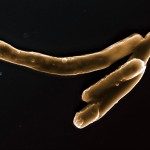Lien vers Pubmed [PMID] – 12010501
Mol. Microbiol. 2002 May;44(4):1109-22
Mycobacterium tuberculosis produces a series of major secreted proteins, the fibronectin-binding proteins (Fbps), also known as the antigen 85 complex, that are believed to play an essential role in the pathogenesis of tuberculosis through their mycoloyltransferase activity required for maintaining the integrity of the bacterial cell envelope. Four different fbp genes are found in the genome of M. tuberculosis, but the reason for the existence of these Fbps sharing the same substrate specificity in vitro in mycobacteria is unknown. We have shown previously that, in the heterologous host, Corynebacterium glutamicum, FbpA, FbpB and FbpC can all add mycoloyl residues to the cell wall arabinogalactan and that, in M. tuberculosis, the cell wall mycoloylation decreases by 40% when fbpC is knocked out. To investigate whether the remaining 60% mycoloylation came from the activity of FbpA and/or FbpB, fbpA- and fbpB-inactivated mutant strains were biochemically characterized and compared with the previously studied fbpC-disrupted mutant. Unexpectedly, both mutants produced normally mycoloylated cell walls. Overproduction of FbpA, FbpB or FbpC, but not FbpD, in the fbpC-inactivated mutant strain of M. tuberculosis restored both the cell wall-linked mycolate defect and the outer cell envelope permeability barrier property. These results are consistent with all three enzymes being involved in cell wall mycoloylation and FbpC playing a more critical role than the others or, alternatively, FbpC is able to compensate for FbpA and FbpB in ways that these enzymes cannot compensate for FbpC, pointing to a partial redundancy of Fbps. In sharp contrast, FbpD does not appear to be an active mycoloyltransferase enzyme, as it cannot complement the fbpC-inactivated mutant. Most importantly, application of Smith degradation to the cell walls of transformants demonstrated that the multiple Fbp enzymes are redundant rather than specific for the various arabinogalactan mycoloylation regions. Neither FbpA nor FbpB attaches mycoloyl residues to specific sites but, like FbpC, each enzyme transfers mycoloyl residues onto the four sites present in the arabinogalactan non-reducing end hexaarabinosides.

